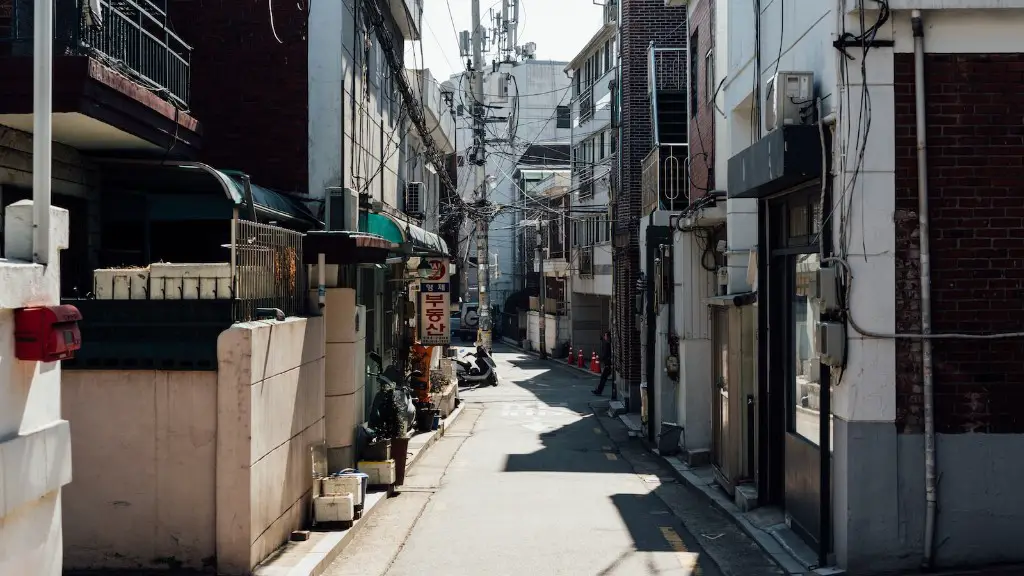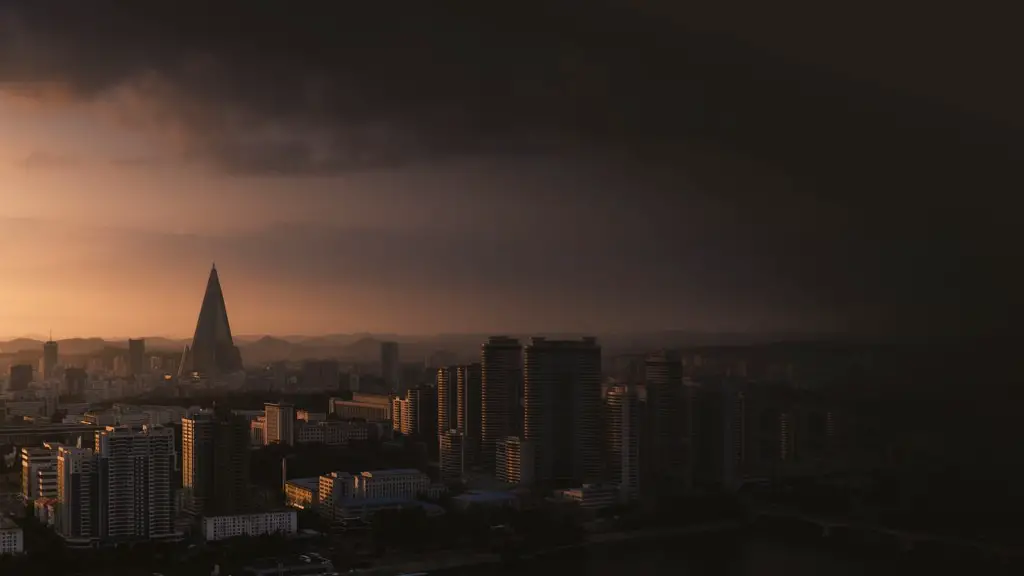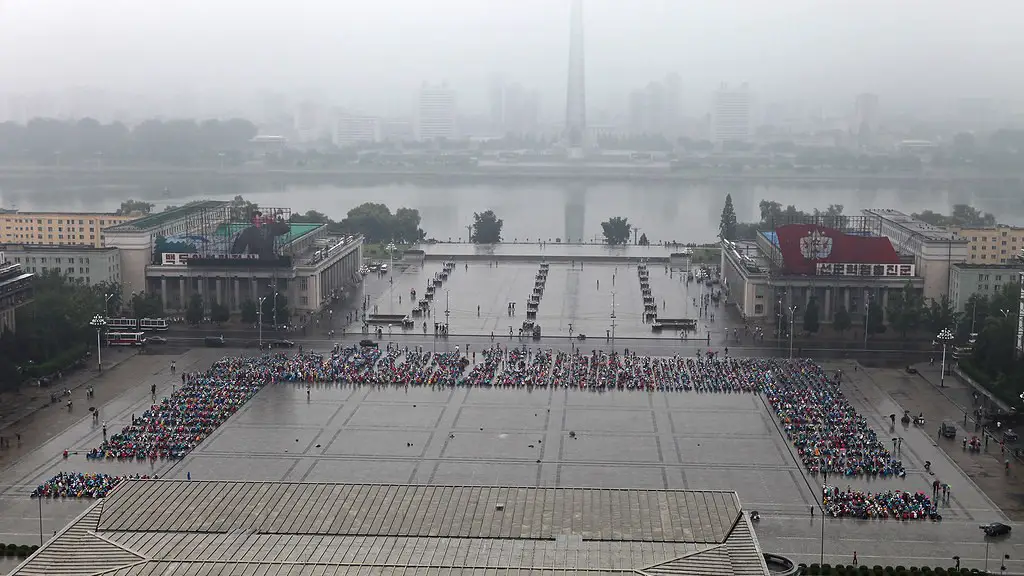Towns
Visiting North Korea is like stepping back in time. The country’s cities, towns, and villages are often referred to as ‘time capsules’ due to their appearance and lack of modernization. When it comes to North Korean towns, there is not a lot of variation. Buildings are usually made of concrete, painted grey and bear no difference from one another, forming an impression of uniformity and stagnation.
Most North Korean towns consist of one straight street, with all the buildings and government facilities located along it. There are few sidewalks, and many parts of the town are very poorly lit. Where available, electric power is provided by bulky generators. There is generally a marked lack of cars in the streets, and most people tend to travel by bicycle.
Age-old customs still dominate the lives of North Koreans. Even in towns, everybody follows the same morning routine. People start their day with early morning ‘sports sessions’, followed by a march to the nearby river and quick wash up. Afterwards, they proceed to the central square for the flag-raising ceremony and listening to the National Anthem. This part of the day is particularly fascinating to look at, as people stop whatever they were doing and focus on the ceremony.
In terms of shopping and leisure, there are few of either available in a North Korean town. Shopping is usually done in the morning markets run by independent vendors, who bring everything from clothes to fish to the marketplace. In terms of leisure activities, most people spend their time relaxing in parks, visiting memorials, or playing outdoor games.
Rural Areas
In contrast to the towns and cities, North Korea’s rural areas are far less developed and represent a true Third World scene. It is not uncommon to see people using horses and carts to get around, or women carrying firewood on their back or grinding corn in hand-run grinders.
Agriculture has traditionally been the main occupation for most North Koreans living in rural areas. Farms are generally divided into small plots of land, and most of the tools used in farming are incredibly primitive. Despite the fact that the soil is fertile and the area is often sunny and temperate, the lack of chemical fertilizers, irrigation systems, and advanced tools means that the land yields are very low.
In terms of housing, most rural dwellings are made from anything from concrete and clay to wood, and are usually lacked plumbing or running water. Electricity is scarce and the few houses that do have it tend to receive it intermittently. It is not uncommon for a North Korean family to live without proper heating or running water.
Despite the extreme living conditions in North Korean rural areas, life goes on. People still find joy in the small daily pleasures, such as singing and playing instruments around the common fire at nighttime.
City Life
A visit to a North Korean city is an entirely different experience from a town or a rural area. Although poverty is still present, the cities appear to be far less affected by it. The streets are usually made of concrete and are mostly well-lit. There are also more cars than in towns, with the more privileged citizens driving the bigger and improved models.
Despite the modernization of the cities, most everyday activities remain much the same. People start their daily routine early in the morning and usually by 10 am they are already finished with their chores. After that, most people leisurely spend the day in parks and gardens, and along the embankments of the city’s rivers.
Shopping-wise, North Korean cities offer far better selection with government-operated stores selling western brands, such as Adidas and Puma, as well in addition to some North Korean manufactured products. Some of the larger stores are equipped with cameras to monitor the buyers, prompting many people to use plastic bags or their hands to hide what they are buying from the watchful eye of the state.
In terms of entertainment, North Korean cities boast a broad selection of options catering to all ages. There are several movie theatres, parks featuring rides and amusements, TV rooms displaying recent South Korean dramas, and crowded dance halls, among many other entertainment venues.
Tourist Areas
North Korea has recognized the potential of tourism and has opened several world-class resorts and attractions open to foreigners. Although, in many ways, they share the same features as the rest of the country, they are usually located in better maintained and more up-to-date areas, and often feature better services.
Perhaps the most iconic of these are the Mount Kumgang resorts, located in the southeast of North Korea. It is not uncommon to see luxury coaches transporting tourists from resorts to the nearby viewpoints, and high-end restaurants with multiple choices of food.
Pyongyang is another tourist destination, featuring a combination of mainly Korean-made monuments and some foreign-made attractions. Of these, the recently opened Pyongyang Water Park stands out as a popular destination. It includes a large pool, several slides and rollercoasters, paddle boats and a bowling alley, among other attractions.
Outside of the main tourist areas, there are also guided tours that offer unique experiences and insights into North Korean life. A good example of this is the North Korean Arirang Festival tour, which allows visitors to witness an impressive display of waves of gymnasts, dancers and singers performing in unison, at the world’s largest stadium.
Culture & People
The North Korean population is generally composed of elderly people and young children, with most young adults and adults having left the country in one way or another. Despite the grim conditions in the country and its aged population, the North Korean people are incredibly friendly and are more than happy to communicate with foreigners.
North Koreans maintain strong traditional values despite the presence of global trends in their country. They are very respectful of their elders and usually follow set customs and principles when interacting with each other. It is understood that visitors are expected to comply with this behavior, and even small gestures such as helping an elderly person or making a small bow when greeting them, will be appreciated.
The North Korean culture is also strong in its beliefs and national pride. It is not unusual to see citizens wearing pins featuring the image of Kim Il-Sung or Kim Jong-Il, or photos with the national flag hanging in people’s living rooms.
Transportation
North Korea’s transportation infrastructure is undeveloped and unreliable. Unpaved dirt roads, railway lines which go at a crawling speed, or buses that don’t run at fixed times are all the norm. Due to the rudimentary nature of the transportation system, most people prefer to move by foot.
When it comes to more comfortable forms of transportation, the most common are international flights to the main airport in Pyongyang, followed by trains and buses on a domestic level. It is important to note that all transportation is heavily monitored, with each passenger being asked to show identification cards or special travel passes.
Travelling by car is also a possibility, but it is strictly limited to foreigners and the lower elite of North Korea. Cars must always display a plate with the designation ‘Ga’ in order to indicate that they belong to a privileged citizen.
Tourism Regulations
As expected, travelling in North Korea involves some regulations and peculiarities. All foreign visitors must have their passports, visas and travel permits checked by the authorities every time they enter a new place. Additionally, international mobile phones are prohibited in the country and all photos must be carefully vetted by the local minders before being taken.
It is not uncommon for the authorities to confiscate cameras of tourists and erase any images they consider suspicious or politically incorrect. For this reason, it is always advisable to upload any photos or videos that are important to the personal computer before leaving the country.
In terms of money, it is only possible to use North Korean Won. Foreigners must exchange their foreign currency for North Korean currency as soon as they enter the country, with the exchange rate being set by the government. It is important to bear in mind that all remaining North Korean currency must be exchanged back to foreign currency before leaving the country.
Safety
Despite its somewhat grim reputation, North Korea is generally a safe country to visit. Crime rates are very low and random physical violence practically nonexistent, especially towards foreigners. Nevertheless, it is advisable to follow the general precautions as in any other destination, such as refraining from taking unnecessary risks and carrying large amounts of cash.
It is also important to note that strict laws are in place in North Korea and breaking them can result in imprisonment, expulsion or worse. Therefore, all advice provided by the guides must be followed to the letter and the constant presence of the minders and foreign systems should be kept in mind at all times.
All in all, North Korea is an incredibly different place, unlike anything else in the world. Despite its challenges and difficulties, the country is uniquely fascinating and makes for an unforgettable experience.


